Learning Theories and Their Impact on Counseling Practices: Unit 19
VerifiedAdded on 2019/12/17
|13
|3918
|278
Report
AI Summary
This report provides a comprehensive overview of various learning theories, including classical conditioning, operant conditioning, Thorndike's Law of Effect, and Bandura's Social Learning Theory. It examines the schedules of reinforcement, the impact of different modeling influences, and the effects of both functional and dysfunctional learning environments on learning and behavior. The report also connects stimulus and response models to social learning models, discussing how these theories can be utilized to create effective programs for changes in counseling practices. Additionally, it highlights the importance of environmental factors in learning and behavior. The report concludes with the formulation of a program for change and the methods of its application in counseling.

UNIT 19
Paraphrase This Document
Need a fresh take? Get an instant paraphrase of this document with our AI Paraphraser
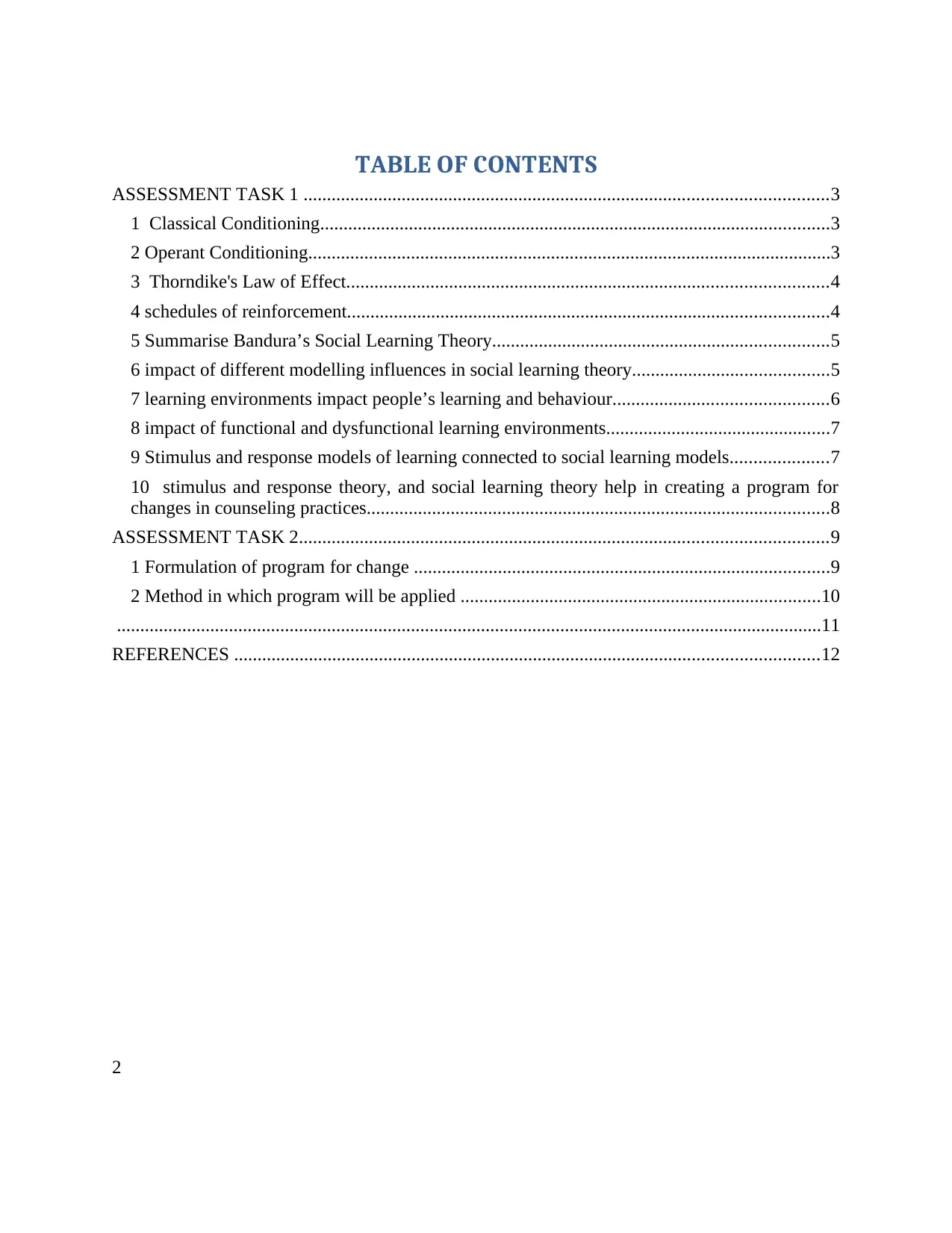
TABLE OF CONTENTS
ASSESSMENT TASK 1 ................................................................................................................3
1 Classical Conditioning.............................................................................................................3
2 Operant Conditioning................................................................................................................3
3 Thorndike's Law of Effect.......................................................................................................4
4 schedules of reinforcement.......................................................................................................4
5 Summarise Bandura’s Social Learning Theory........................................................................5
6 impact of different modelling influences in social learning theory..........................................5
7 learning environments impact people’s learning and behaviour..............................................6
8 impact of functional and dysfunctional learning environments................................................7
9 Stimulus and response models of learning connected to social learning models.....................7
10 stimulus and response theory, and social learning theory help in creating a program for
changes in counseling practices...................................................................................................8
ASSESSMENT TASK 2.................................................................................................................9
1 Formulation of program for change .........................................................................................9
2 Method in which program will be applied .............................................................................10
.......................................................................................................................................................11
REFERENCES .............................................................................................................................12
2
ASSESSMENT TASK 1 ................................................................................................................3
1 Classical Conditioning.............................................................................................................3
2 Operant Conditioning................................................................................................................3
3 Thorndike's Law of Effect.......................................................................................................4
4 schedules of reinforcement.......................................................................................................4
5 Summarise Bandura’s Social Learning Theory........................................................................5
6 impact of different modelling influences in social learning theory..........................................5
7 learning environments impact people’s learning and behaviour..............................................6
8 impact of functional and dysfunctional learning environments................................................7
9 Stimulus and response models of learning connected to social learning models.....................7
10 stimulus and response theory, and social learning theory help in creating a program for
changes in counseling practices...................................................................................................8
ASSESSMENT TASK 2.................................................................................................................9
1 Formulation of program for change .........................................................................................9
2 Method in which program will be applied .............................................................................10
.......................................................................................................................................................11
REFERENCES .............................................................................................................................12
2

ASSESSMENT TASK 1
1 Classical Conditioning
Classical conditioning is a learning theory in which knowledge and information is
acquired between a naturally occurring and environmental stimulus. Some assumptions are used
under classical conditioning and it supports in the overall learning procedure. According to
classical conditioning theory, complete learning occurs through interaction with the environment
and behaviour is also shaped due to the same. Association between external and internal stimulus
results in learned response (Harker, Mahar & Wilkes, 2016).. Initially a naturally occurring
stimulus elicits a response and unconditioned stimulus gives response as a result of same.
Automatic and responsive responses are included under it and a neutral stimulus is paired
with an unconditioned stimulus. According to classical conditioning approach, learning occurs
through a systematic approach and process in which response is elicited by external stimuli.
Conditioned stimulus is neutral stimulus that starts a response and reflex outcome is given by
unconditioned stimulant (External stimulus .2017). Conditioned stimulus gives response towards
the unconditioned stimulus and predictions are given to unconditional stimulus. Behaviours are
modified through association of stimuli and overall learning process depends upon the same
(Talbot-Smith, Abell & Hanuscin, 2013). Conditioned response is generally similar to
unconditioned response and Ivan Pavlov gave a theory by conducting study on various stimulus.
2 Operant Conditioning.
According to operant conditioning, it has been observed that there are two types of
reinforcements naming as positive and negative. In negative reinforcement, behaviour or
response given by a stimulus is Strengthened by removing, avoiding and stopping a negative
outcome. Negative reinforcement is given under an operant conditioning and due to that, it
becomes easier for strengthening the desired behaviour (Bresler, 2013). As per the theory of
operant conditioning, the best way to understand the behaviour of an individual is to look at the
root cause and consequences received from that behaviour.
Intentional actions that give impact on the surrounding environment are main operant and
identification of procedures is done because of which certain behaviour or actions generally
occur. Neutral operant are those responses in which probability of repeating the behaviour is
3
1 Classical Conditioning
Classical conditioning is a learning theory in which knowledge and information is
acquired between a naturally occurring and environmental stimulus. Some assumptions are used
under classical conditioning and it supports in the overall learning procedure. According to
classical conditioning theory, complete learning occurs through interaction with the environment
and behaviour is also shaped due to the same. Association between external and internal stimulus
results in learned response (Harker, Mahar & Wilkes, 2016).. Initially a naturally occurring
stimulus elicits a response and unconditioned stimulus gives response as a result of same.
Automatic and responsive responses are included under it and a neutral stimulus is paired
with an unconditioned stimulus. According to classical conditioning approach, learning occurs
through a systematic approach and process in which response is elicited by external stimuli.
Conditioned stimulus is neutral stimulus that starts a response and reflex outcome is given by
unconditioned stimulant (External stimulus .2017). Conditioned stimulus gives response towards
the unconditioned stimulus and predictions are given to unconditional stimulus. Behaviours are
modified through association of stimuli and overall learning process depends upon the same
(Talbot-Smith, Abell & Hanuscin, 2013). Conditioned response is generally similar to
unconditioned response and Ivan Pavlov gave a theory by conducting study on various stimulus.
2 Operant Conditioning.
According to operant conditioning, it has been observed that there are two types of
reinforcements naming as positive and negative. In negative reinforcement, behaviour or
response given by a stimulus is Strengthened by removing, avoiding and stopping a negative
outcome. Negative reinforcement is given under an operant conditioning and due to that, it
becomes easier for strengthening the desired behaviour (Bresler, 2013). As per the theory of
operant conditioning, the best way to understand the behaviour of an individual is to look at the
root cause and consequences received from that behaviour.
Intentional actions that give impact on the surrounding environment are main operant and
identification of procedures is done because of which certain behaviour or actions generally
occur. Neutral operant are those responses in which probability of repeating the behaviour is
3
⊘ This is a preview!⊘
Do you want full access?
Subscribe today to unlock all pages.

Trusted by 1+ million students worldwide
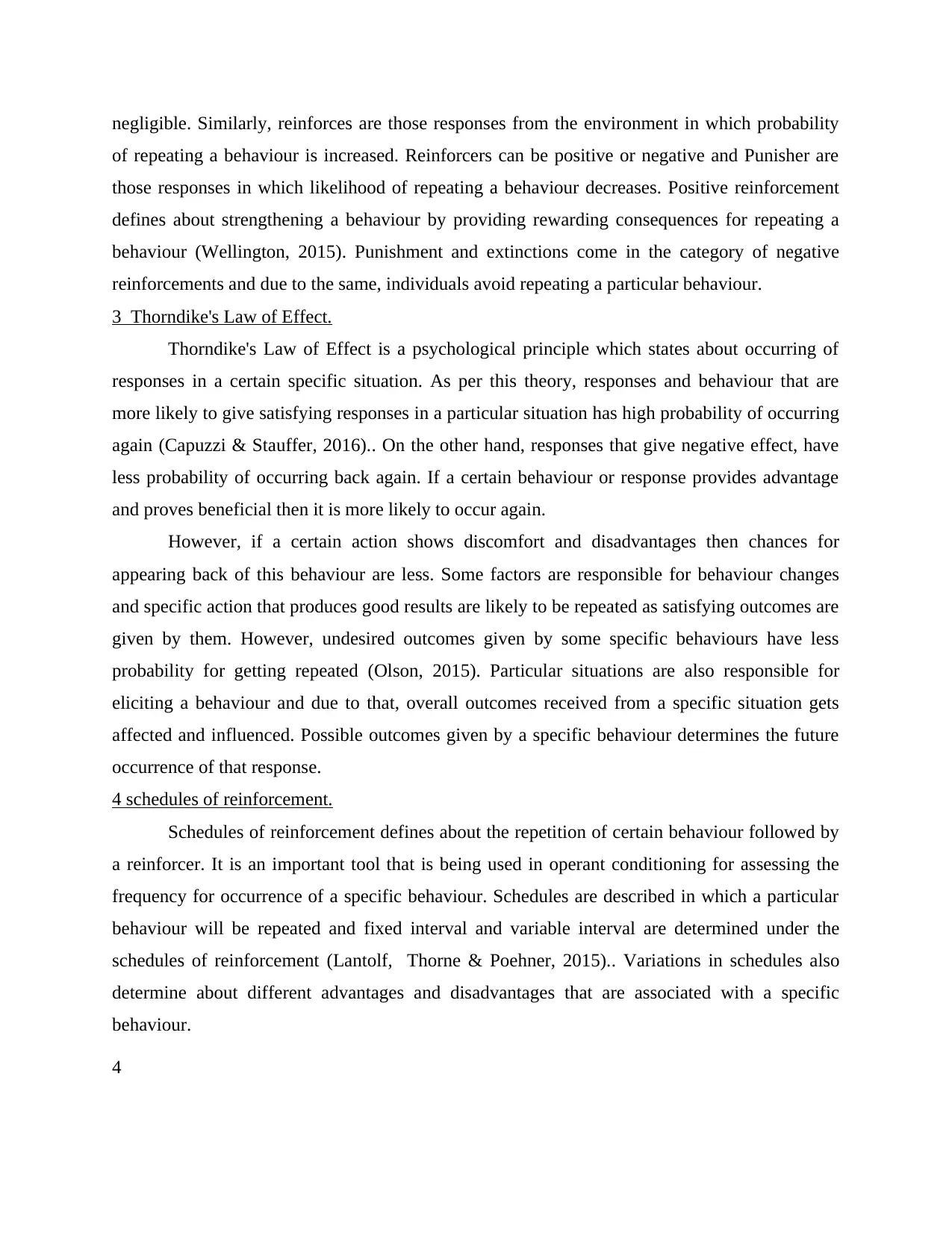
negligible. Similarly, reinforces are those responses from the environment in which probability
of repeating a behaviour is increased. Reinforcers can be positive or negative and Punisher are
those responses in which likelihood of repeating a behaviour decreases. Positive reinforcement
defines about strengthening a behaviour by providing rewarding consequences for repeating a
behaviour (Wellington, 2015). Punishment and extinctions come in the category of negative
reinforcements and due to the same, individuals avoid repeating a particular behaviour.
3 Thorndike's Law of Effect.
Thorndike's Law of Effect is a psychological principle which states about occurring of
responses in a certain specific situation. As per this theory, responses and behaviour that are
more likely to give satisfying responses in a particular situation has high probability of occurring
again (Capuzzi & Stauffer, 2016).. On the other hand, responses that give negative effect, have
less probability of occurring back again. If a certain behaviour or response provides advantage
and proves beneficial then it is more likely to occur again.
However, if a certain action shows discomfort and disadvantages then chances for
appearing back of this behaviour are less. Some factors are responsible for behaviour changes
and specific action that produces good results are likely to be repeated as satisfying outcomes are
given by them. However, undesired outcomes given by some specific behaviours have less
probability for getting repeated (Olson, 2015). Particular situations are also responsible for
eliciting a behaviour and due to that, overall outcomes received from a specific situation gets
affected and influenced. Possible outcomes given by a specific behaviour determines the future
occurrence of that response.
4 schedules of reinforcement.
Schedules of reinforcement defines about the repetition of certain behaviour followed by
a reinforcer. It is an important tool that is being used in operant conditioning for assessing the
frequency for occurrence of a specific behaviour. Schedules are described in which a particular
behaviour will be repeated and fixed interval and variable interval are determined under the
schedules of reinforcement (Lantolf, Thorne & Poehner, 2015).. Variations in schedules also
determine about different advantages and disadvantages that are associated with a specific
behaviour.
4
of repeating a behaviour is increased. Reinforcers can be positive or negative and Punisher are
those responses in which likelihood of repeating a behaviour decreases. Positive reinforcement
defines about strengthening a behaviour by providing rewarding consequences for repeating a
behaviour (Wellington, 2015). Punishment and extinctions come in the category of negative
reinforcements and due to the same, individuals avoid repeating a particular behaviour.
3 Thorndike's Law of Effect.
Thorndike's Law of Effect is a psychological principle which states about occurring of
responses in a certain specific situation. As per this theory, responses and behaviour that are
more likely to give satisfying responses in a particular situation has high probability of occurring
again (Capuzzi & Stauffer, 2016).. On the other hand, responses that give negative effect, have
less probability of occurring back again. If a certain behaviour or response provides advantage
and proves beneficial then it is more likely to occur again.
However, if a certain action shows discomfort and disadvantages then chances for
appearing back of this behaviour are less. Some factors are responsible for behaviour changes
and specific action that produces good results are likely to be repeated as satisfying outcomes are
given by them. However, undesired outcomes given by some specific behaviours have less
probability for getting repeated (Olson, 2015). Particular situations are also responsible for
eliciting a behaviour and due to that, overall outcomes received from a specific situation gets
affected and influenced. Possible outcomes given by a specific behaviour determines the future
occurrence of that response.
4 schedules of reinforcement.
Schedules of reinforcement defines about the repetition of certain behaviour followed by
a reinforcer. It is an important tool that is being used in operant conditioning for assessing the
frequency for occurrence of a specific behaviour. Schedules are described in which a particular
behaviour will be repeated and fixed interval and variable interval are determined under the
schedules of reinforcement (Lantolf, Thorne & Poehner, 2015).. Variations in schedules also
determine about different advantages and disadvantages that are associated with a specific
behaviour.
4
Paraphrase This Document
Need a fresh take? Get an instant paraphrase of this document with our AI Paraphraser
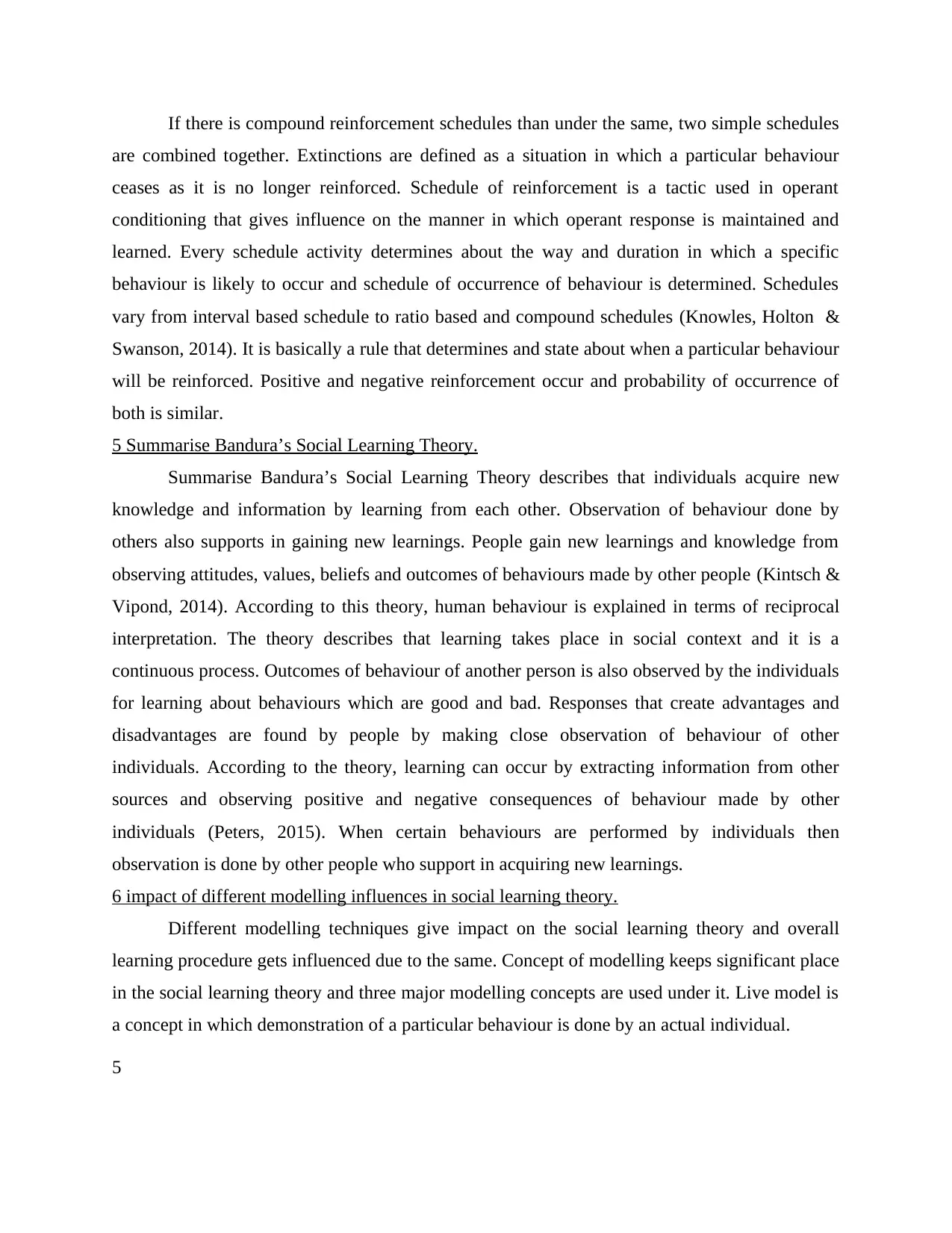
If there is compound reinforcement schedules than under the same, two simple schedules
are combined together. Extinctions are defined as a situation in which a particular behaviour
ceases as it is no longer reinforced. Schedule of reinforcement is a tactic used in operant
conditioning that gives influence on the manner in which operant response is maintained and
learned. Every schedule activity determines about the way and duration in which a specific
behaviour is likely to occur and schedule of occurrence of behaviour is determined. Schedules
vary from interval based schedule to ratio based and compound schedules (Knowles, Holton &
Swanson, 2014). It is basically a rule that determines and state about when a particular behaviour
will be reinforced. Positive and negative reinforcement occur and probability of occurrence of
both is similar.
5 Summarise Bandura’s Social Learning Theory.
Summarise Bandura’s Social Learning Theory describes that individuals acquire new
knowledge and information by learning from each other. Observation of behaviour done by
others also supports in gaining new learnings. People gain new learnings and knowledge from
observing attitudes, values, beliefs and outcomes of behaviours made by other people (Kintsch &
Vipond, 2014). According to this theory, human behaviour is explained in terms of reciprocal
interpretation. The theory describes that learning takes place in social context and it is a
continuous process. Outcomes of behaviour of another person is also observed by the individuals
for learning about behaviours which are good and bad. Responses that create advantages and
disadvantages are found by people by making close observation of behaviour of other
individuals. According to the theory, learning can occur by extracting information from other
sources and observing positive and negative consequences of behaviour made by other
individuals (Peters, 2015). When certain behaviours are performed by individuals then
observation is done by other people who support in acquiring new learnings.
6 impact of different modelling influences in social learning theory.
Different modelling techniques give impact on the social learning theory and overall
learning procedure gets influenced due to the same. Concept of modelling keeps significant place
in the social learning theory and three major modelling concepts are used under it. Live model is
a concept in which demonstration of a particular behaviour is done by an actual individual.
5
are combined together. Extinctions are defined as a situation in which a particular behaviour
ceases as it is no longer reinforced. Schedule of reinforcement is a tactic used in operant
conditioning that gives influence on the manner in which operant response is maintained and
learned. Every schedule activity determines about the way and duration in which a specific
behaviour is likely to occur and schedule of occurrence of behaviour is determined. Schedules
vary from interval based schedule to ratio based and compound schedules (Knowles, Holton &
Swanson, 2014). It is basically a rule that determines and state about when a particular behaviour
will be reinforced. Positive and negative reinforcement occur and probability of occurrence of
both is similar.
5 Summarise Bandura’s Social Learning Theory.
Summarise Bandura’s Social Learning Theory describes that individuals acquire new
knowledge and information by learning from each other. Observation of behaviour done by
others also supports in gaining new learnings. People gain new learnings and knowledge from
observing attitudes, values, beliefs and outcomes of behaviours made by other people (Kintsch &
Vipond, 2014). According to this theory, human behaviour is explained in terms of reciprocal
interpretation. The theory describes that learning takes place in social context and it is a
continuous process. Outcomes of behaviour of another person is also observed by the individuals
for learning about behaviours which are good and bad. Responses that create advantages and
disadvantages are found by people by making close observation of behaviour of other
individuals. According to the theory, learning can occur by extracting information from other
sources and observing positive and negative consequences of behaviour made by other
individuals (Peters, 2015). When certain behaviours are performed by individuals then
observation is done by other people who support in acquiring new learnings.
6 impact of different modelling influences in social learning theory.
Different modelling techniques give impact on the social learning theory and overall
learning procedure gets influenced due to the same. Concept of modelling keeps significant place
in the social learning theory and three major modelling concepts are used under it. Live model is
a concept in which demonstration of a particular behaviour is done by an actual individual.
5
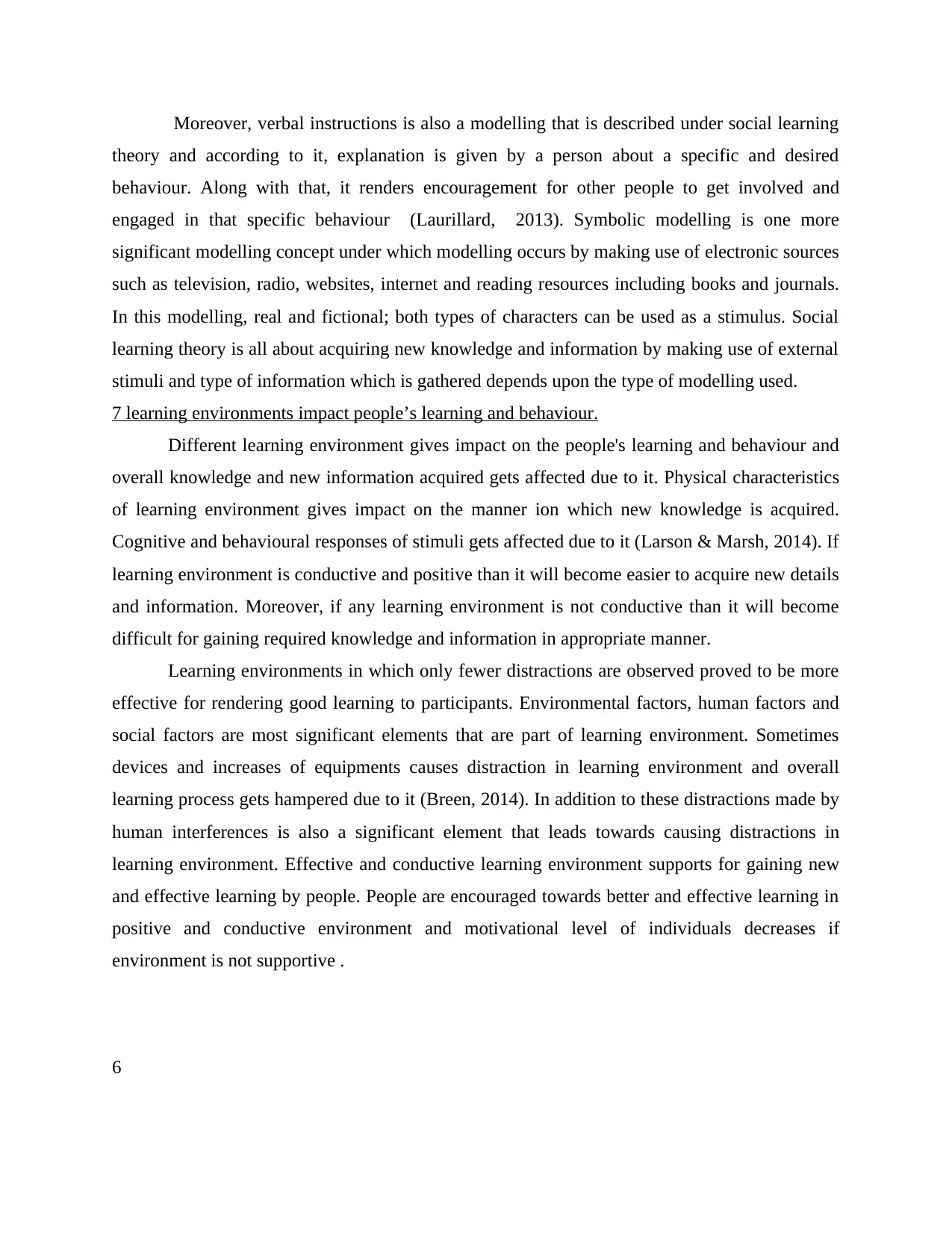
Moreover, verbal instructions is also a modelling that is described under social learning
theory and according to it, explanation is given by a person about a specific and desired
behaviour. Along with that, it renders encouragement for other people to get involved and
engaged in that specific behaviour (Laurillard, 2013). Symbolic modelling is one more
significant modelling concept under which modelling occurs by making use of electronic sources
such as television, radio, websites, internet and reading resources including books and journals.
In this modelling, real and fictional; both types of characters can be used as a stimulus. Social
learning theory is all about acquiring new knowledge and information by making use of external
stimuli and type of information which is gathered depends upon the type of modelling used.
7 learning environments impact people’s learning and behaviour.
Different learning environment gives impact on the people's learning and behaviour and
overall knowledge and new information acquired gets affected due to it. Physical characteristics
of learning environment gives impact on the manner ion which new knowledge is acquired.
Cognitive and behavioural responses of stimuli gets affected due to it (Larson & Marsh, 2014). If
learning environment is conductive and positive than it will become easier to acquire new details
and information. Moreover, if any learning environment is not conductive than it will become
difficult for gaining required knowledge and information in appropriate manner.
Learning environments in which only fewer distractions are observed proved to be more
effective for rendering good learning to participants. Environmental factors, human factors and
social factors are most significant elements that are part of learning environment. Sometimes
devices and increases of equipments causes distraction in learning environment and overall
learning process gets hampered due to it (Breen, 2014). In addition to these distractions made by
human interferences is also a significant element that leads towards causing distractions in
learning environment. Effective and conductive learning environment supports for gaining new
and effective learning by people. People are encouraged towards better and effective learning in
positive and conductive environment and motivational level of individuals decreases if
environment is not supportive .
6
theory and according to it, explanation is given by a person about a specific and desired
behaviour. Along with that, it renders encouragement for other people to get involved and
engaged in that specific behaviour (Laurillard, 2013). Symbolic modelling is one more
significant modelling concept under which modelling occurs by making use of electronic sources
such as television, radio, websites, internet and reading resources including books and journals.
In this modelling, real and fictional; both types of characters can be used as a stimulus. Social
learning theory is all about acquiring new knowledge and information by making use of external
stimuli and type of information which is gathered depends upon the type of modelling used.
7 learning environments impact people’s learning and behaviour.
Different learning environment gives impact on the people's learning and behaviour and
overall knowledge and new information acquired gets affected due to it. Physical characteristics
of learning environment gives impact on the manner ion which new knowledge is acquired.
Cognitive and behavioural responses of stimuli gets affected due to it (Larson & Marsh, 2014). If
learning environment is conductive and positive than it will become easier to acquire new details
and information. Moreover, if any learning environment is not conductive than it will become
difficult for gaining required knowledge and information in appropriate manner.
Learning environments in which only fewer distractions are observed proved to be more
effective for rendering good learning to participants. Environmental factors, human factors and
social factors are most significant elements that are part of learning environment. Sometimes
devices and increases of equipments causes distraction in learning environment and overall
learning process gets hampered due to it (Breen, 2014). In addition to these distractions made by
human interferences is also a significant element that leads towards causing distractions in
learning environment. Effective and conductive learning environment supports for gaining new
and effective learning by people. People are encouraged towards better and effective learning in
positive and conductive environment and motivational level of individuals decreases if
environment is not supportive .
6
⊘ This is a preview!⊘
Do you want full access?
Subscribe today to unlock all pages.

Trusted by 1+ million students worldwide
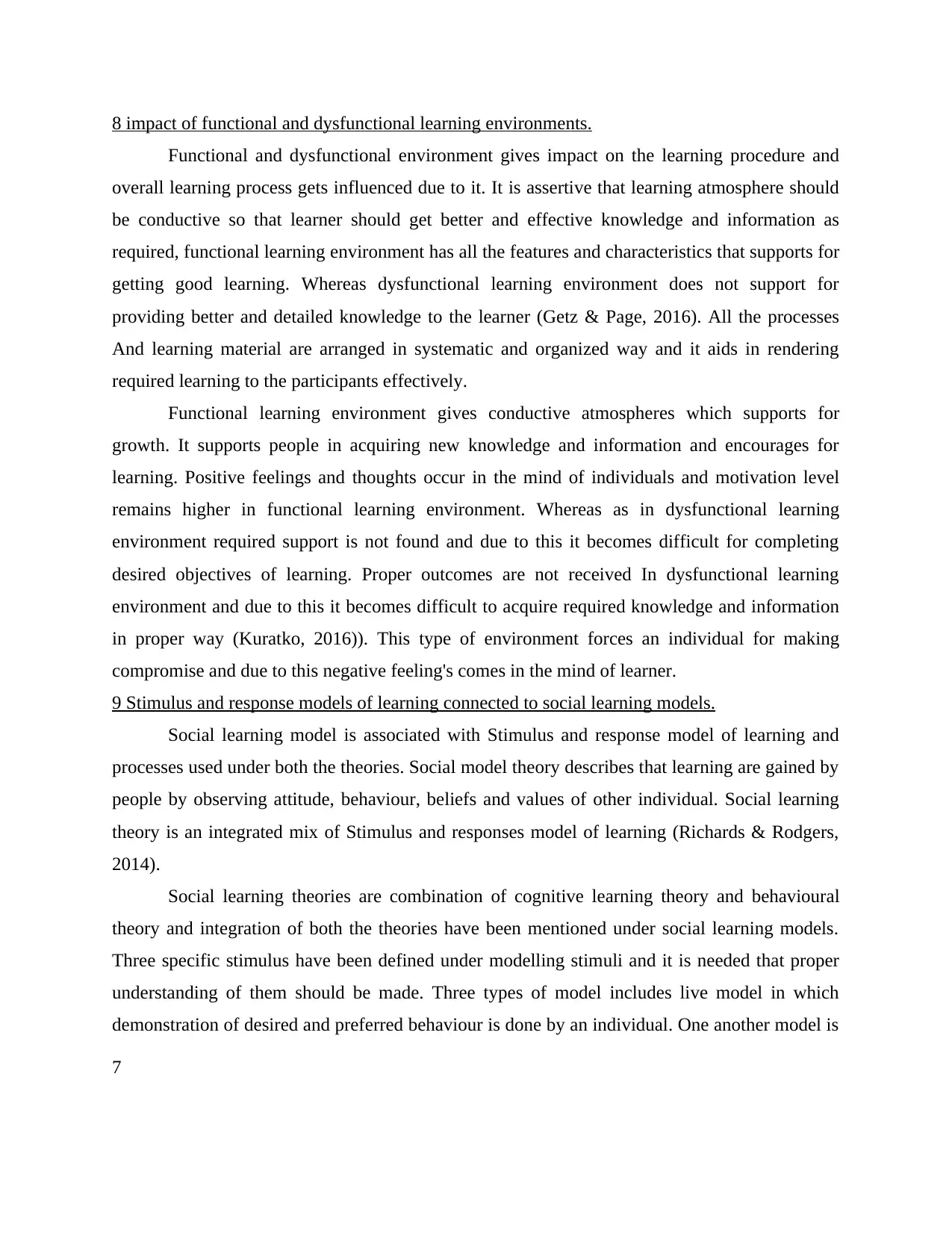
8 impact of functional and dysfunctional learning environments.
Functional and dysfunctional environment gives impact on the learning procedure and
overall learning process gets influenced due to it. It is assertive that learning atmosphere should
be conductive so that learner should get better and effective knowledge and information as
required, functional learning environment has all the features and characteristics that supports for
getting good learning. Whereas dysfunctional learning environment does not support for
providing better and detailed knowledge to the learner (Getz & Page, 2016). All the processes
And learning material are arranged in systematic and organized way and it aids in rendering
required learning to the participants effectively.
Functional learning environment gives conductive atmospheres which supports for
growth. It supports people in acquiring new knowledge and information and encourages for
learning. Positive feelings and thoughts occur in the mind of individuals and motivation level
remains higher in functional learning environment. Whereas as in dysfunctional learning
environment required support is not found and due to this it becomes difficult for completing
desired objectives of learning. Proper outcomes are not received In dysfunctional learning
environment and due to this it becomes difficult to acquire required knowledge and information
in proper way (Kuratko, 2016)). This type of environment forces an individual for making
compromise and due to this negative feeling's comes in the mind of learner.
9 Stimulus and response models of learning connected to social learning models.
Social learning model is associated with Stimulus and response model of learning and
processes used under both the theories. Social model theory describes that learning are gained by
people by observing attitude, behaviour, beliefs and values of other individual. Social learning
theory is an integrated mix of Stimulus and responses model of learning (Richards & Rodgers,
2014).
Social learning theories are combination of cognitive learning theory and behavioural
theory and integration of both the theories have been mentioned under social learning models.
Three specific stimulus have been defined under modelling stimuli and it is needed that proper
understanding of them should be made. Three types of model includes live model in which
demonstration of desired and preferred behaviour is done by an individual. One another model is
7
Functional and dysfunctional environment gives impact on the learning procedure and
overall learning process gets influenced due to it. It is assertive that learning atmosphere should
be conductive so that learner should get better and effective knowledge and information as
required, functional learning environment has all the features and characteristics that supports for
getting good learning. Whereas dysfunctional learning environment does not support for
providing better and detailed knowledge to the learner (Getz & Page, 2016). All the processes
And learning material are arranged in systematic and organized way and it aids in rendering
required learning to the participants effectively.
Functional learning environment gives conductive atmospheres which supports for
growth. It supports people in acquiring new knowledge and information and encourages for
learning. Positive feelings and thoughts occur in the mind of individuals and motivation level
remains higher in functional learning environment. Whereas as in dysfunctional learning
environment required support is not found and due to this it becomes difficult for completing
desired objectives of learning. Proper outcomes are not received In dysfunctional learning
environment and due to this it becomes difficult to acquire required knowledge and information
in proper way (Kuratko, 2016)). This type of environment forces an individual for making
compromise and due to this negative feeling's comes in the mind of learner.
9 Stimulus and response models of learning connected to social learning models.
Social learning model is associated with Stimulus and response model of learning and
processes used under both the theories. Social model theory describes that learning are gained by
people by observing attitude, behaviour, beliefs and values of other individual. Social learning
theory is an integrated mix of Stimulus and responses model of learning (Richards & Rodgers,
2014).
Social learning theories are combination of cognitive learning theory and behavioural
theory and integration of both the theories have been mentioned under social learning models.
Three specific stimulus have been defined under modelling stimuli and it is needed that proper
understanding of them should be made. Three types of model includes live model in which
demonstration of desired and preferred behaviour is done by an individual. One another model is
7
Paraphrase This Document
Need a fresh take? Get an instant paraphrase of this document with our AI Paraphraser

verbal instruction in which desired behaviour and responses are explained by a specific
individual and it aids in encouraging other participants to take part in the learning process.
Symbolic model defines about adopting learning by making use of television, radio, internet and
literature sources (Harker, Mahar & Wilkes, 2016). All the social learning models have
responses and stimuli and due to it all explains about learning procedures.
10 stimulus and response theory, and social learning theory help in creating a program for
changes in counseling practices
Stimulus and response theory and social learning theory helps in creating a program for
change in counseling practices. New and innovative methods can be adopted for making
modifications in existing counseling sessions and due to that it becomes easier for accomplishing
the desired aims and goals of counseling sessions (Talbot-Smith, Abell & Hanuscin, 2013).
Origin of issues and root cause behind a specific problem can be easily identified and better
methods can be identified for resolving the issues in effective way.
Learning theories states that behavior of an individual is learned from exposure to
punishments and rewards. Stimulus and response theory and social learning theory aids in
identifying possible causes that leads towards elicitation of certain behavior in an individual.
New methods and techniques can be added in the counseling practices by making use of
guidelines that are being mentioned in the social theory and Stimulus and response theory.
Moreover, counseling practices can be carried out effectively by making use of both the theories
and it will also support for completing all the objectives of counseling sessions (Bresler, 2013).
8
individual and it aids in encouraging other participants to take part in the learning process.
Symbolic model defines about adopting learning by making use of television, radio, internet and
literature sources (Harker, Mahar & Wilkes, 2016). All the social learning models have
responses and stimuli and due to it all explains about learning procedures.
10 stimulus and response theory, and social learning theory help in creating a program for
changes in counseling practices
Stimulus and response theory and social learning theory helps in creating a program for
change in counseling practices. New and innovative methods can be adopted for making
modifications in existing counseling sessions and due to that it becomes easier for accomplishing
the desired aims and goals of counseling sessions (Talbot-Smith, Abell & Hanuscin, 2013).
Origin of issues and root cause behind a specific problem can be easily identified and better
methods can be identified for resolving the issues in effective way.
Learning theories states that behavior of an individual is learned from exposure to
punishments and rewards. Stimulus and response theory and social learning theory aids in
identifying possible causes that leads towards elicitation of certain behavior in an individual.
New methods and techniques can be added in the counseling practices by making use of
guidelines that are being mentioned in the social theory and Stimulus and response theory.
Moreover, counseling practices can be carried out effectively by making use of both the theories
and it will also support for completing all the objectives of counseling sessions (Bresler, 2013).
8
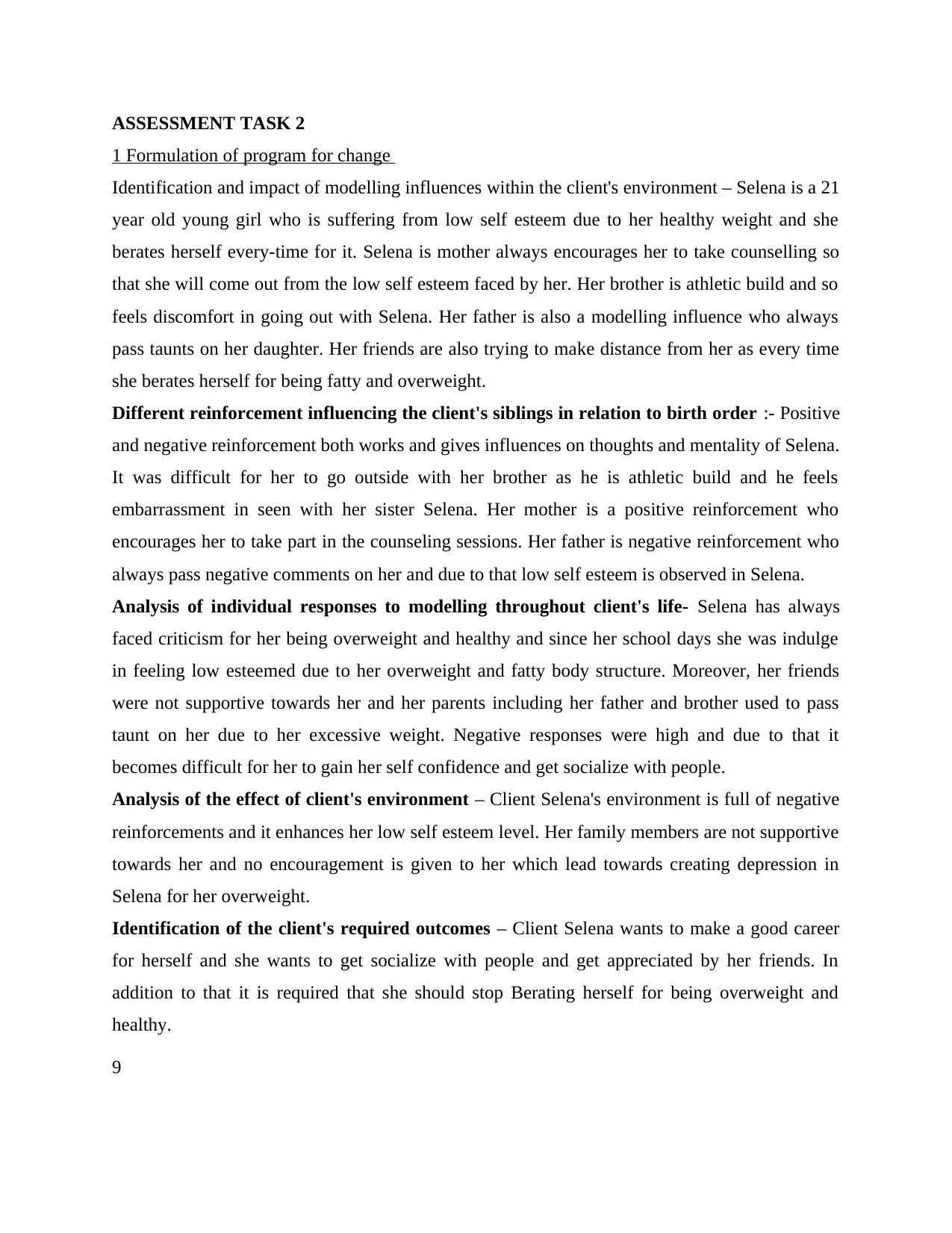
ASSESSMENT TASK 2
1 Formulation of program for change
Identification and impact of modelling influences within the client's environment – Selena is a 21
year old young girl who is suffering from low self esteem due to her healthy weight and she
berates herself every-time for it. Selena is mother always encourages her to take counselling so
that she will come out from the low self esteem faced by her. Her brother is athletic build and so
feels discomfort in going out with Selena. Her father is also a modelling influence who always
pass taunts on her daughter. Her friends are also trying to make distance from her as every time
she berates herself for being fatty and overweight.
Different reinforcement influencing the client's siblings in relation to birth order :- Positive
and negative reinforcement both works and gives influences on thoughts and mentality of Selena.
It was difficult for her to go outside with her brother as he is athletic build and he feels
embarrassment in seen with her sister Selena. Her mother is a positive reinforcement who
encourages her to take part in the counseling sessions. Her father is negative reinforcement who
always pass negative comments on her and due to that low self esteem is observed in Selena.
Analysis of individual responses to modelling throughout client's life- Selena has always
faced criticism for her being overweight and healthy and since her school days she was indulge
in feeling low esteemed due to her overweight and fatty body structure. Moreover, her friends
were not supportive towards her and her parents including her father and brother used to pass
taunt on her due to her excessive weight. Negative responses were high and due to that it
becomes difficult for her to gain her self confidence and get socialize with people.
Analysis of the effect of client's environment – Client Selena's environment is full of negative
reinforcements and it enhances her low self esteem level. Her family members are not supportive
towards her and no encouragement is given to her which lead towards creating depression in
Selena for her overweight.
Identification of the client's required outcomes – Client Selena wants to make a good career
for herself and she wants to get socialize with people and get appreciated by her friends. In
addition to that it is required that she should stop Berating herself for being overweight and
healthy.
9
1 Formulation of program for change
Identification and impact of modelling influences within the client's environment – Selena is a 21
year old young girl who is suffering from low self esteem due to her healthy weight and she
berates herself every-time for it. Selena is mother always encourages her to take counselling so
that she will come out from the low self esteem faced by her. Her brother is athletic build and so
feels discomfort in going out with Selena. Her father is also a modelling influence who always
pass taunts on her daughter. Her friends are also trying to make distance from her as every time
she berates herself for being fatty and overweight.
Different reinforcement influencing the client's siblings in relation to birth order :- Positive
and negative reinforcement both works and gives influences on thoughts and mentality of Selena.
It was difficult for her to go outside with her brother as he is athletic build and he feels
embarrassment in seen with her sister Selena. Her mother is a positive reinforcement who
encourages her to take part in the counseling sessions. Her father is negative reinforcement who
always pass negative comments on her and due to that low self esteem is observed in Selena.
Analysis of individual responses to modelling throughout client's life- Selena has always
faced criticism for her being overweight and healthy and since her school days she was indulge
in feeling low esteemed due to her overweight and fatty body structure. Moreover, her friends
were not supportive towards her and her parents including her father and brother used to pass
taunt on her due to her excessive weight. Negative responses were high and due to that it
becomes difficult for her to gain her self confidence and get socialize with people.
Analysis of the effect of client's environment – Client Selena's environment is full of negative
reinforcements and it enhances her low self esteem level. Her family members are not supportive
towards her and no encouragement is given to her which lead towards creating depression in
Selena for her overweight.
Identification of the client's required outcomes – Client Selena wants to make a good career
for herself and she wants to get socialize with people and get appreciated by her friends. In
addition to that it is required that she should stop Berating herself for being overweight and
healthy.
9
⊘ This is a preview!⊘
Do you want full access?
Subscribe today to unlock all pages.

Trusted by 1+ million students worldwide
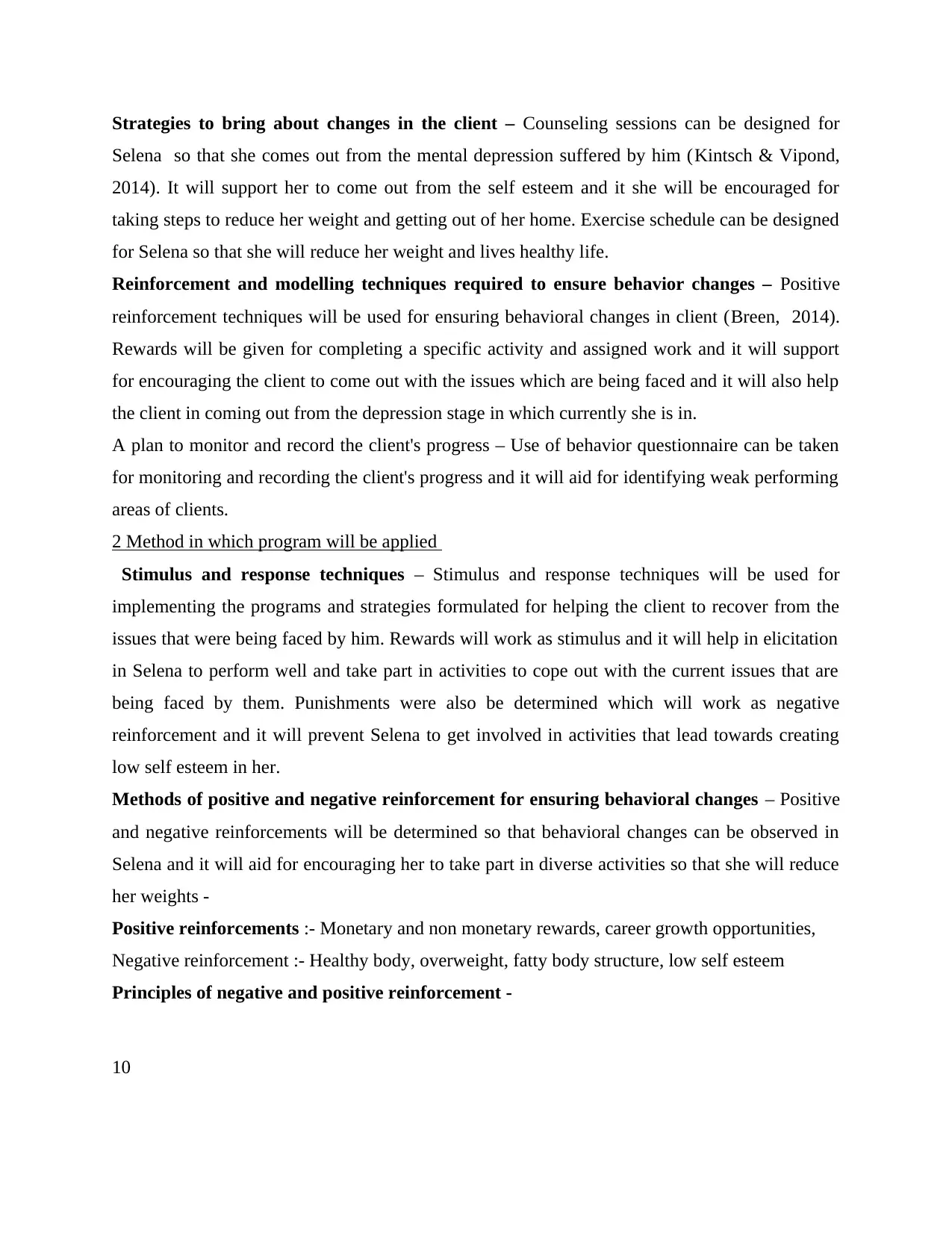
Strategies to bring about changes in the client – Counseling sessions can be designed for
Selena so that she comes out from the mental depression suffered by him (Kintsch & Vipond,
2014). It will support her to come out from the self esteem and it she will be encouraged for
taking steps to reduce her weight and getting out of her home. Exercise schedule can be designed
for Selena so that she will reduce her weight and lives healthy life.
Reinforcement and modelling techniques required to ensure behavior changes – Positive
reinforcement techniques will be used for ensuring behavioral changes in client (Breen, 2014).
Rewards will be given for completing a specific activity and assigned work and it will support
for encouraging the client to come out with the issues which are being faced and it will also help
the client in coming out from the depression stage in which currently she is in.
A plan to monitor and record the client's progress – Use of behavior questionnaire can be taken
for monitoring and recording the client's progress and it will aid for identifying weak performing
areas of clients.
2 Method in which program will be applied
Stimulus and response techniques – Stimulus and response techniques will be used for
implementing the programs and strategies formulated for helping the client to recover from the
issues that were being faced by him. Rewards will work as stimulus and it will help in elicitation
in Selena to perform well and take part in activities to cope out with the current issues that are
being faced by them. Punishments were also be determined which will work as negative
reinforcement and it will prevent Selena to get involved in activities that lead towards creating
low self esteem in her.
Methods of positive and negative reinforcement for ensuring behavioral changes – Positive
and negative reinforcements will be determined so that behavioral changes can be observed in
Selena and it will aid for encouraging her to take part in diverse activities so that she will reduce
her weights -
Positive reinforcements :- Monetary and non monetary rewards, career growth opportunities,
Negative reinforcement :- Healthy body, overweight, fatty body structure, low self esteem
Principles of negative and positive reinforcement -
10
Selena so that she comes out from the mental depression suffered by him (Kintsch & Vipond,
2014). It will support her to come out from the self esteem and it she will be encouraged for
taking steps to reduce her weight and getting out of her home. Exercise schedule can be designed
for Selena so that she will reduce her weight and lives healthy life.
Reinforcement and modelling techniques required to ensure behavior changes – Positive
reinforcement techniques will be used for ensuring behavioral changes in client (Breen, 2014).
Rewards will be given for completing a specific activity and assigned work and it will support
for encouraging the client to come out with the issues which are being faced and it will also help
the client in coming out from the depression stage in which currently she is in.
A plan to monitor and record the client's progress – Use of behavior questionnaire can be taken
for monitoring and recording the client's progress and it will aid for identifying weak performing
areas of clients.
2 Method in which program will be applied
Stimulus and response techniques – Stimulus and response techniques will be used for
implementing the programs and strategies formulated for helping the client to recover from the
issues that were being faced by him. Rewards will work as stimulus and it will help in elicitation
in Selena to perform well and take part in activities to cope out with the current issues that are
being faced by them. Punishments were also be determined which will work as negative
reinforcement and it will prevent Selena to get involved in activities that lead towards creating
low self esteem in her.
Methods of positive and negative reinforcement for ensuring behavioral changes – Positive
and negative reinforcements will be determined so that behavioral changes can be observed in
Selena and it will aid for encouraging her to take part in diverse activities so that she will reduce
her weights -
Positive reinforcements :- Monetary and non monetary rewards, career growth opportunities,
Negative reinforcement :- Healthy body, overweight, fatty body structure, low self esteem
Principles of negative and positive reinforcement -
10
Paraphrase This Document
Need a fresh take? Get an instant paraphrase of this document with our AI Paraphraser
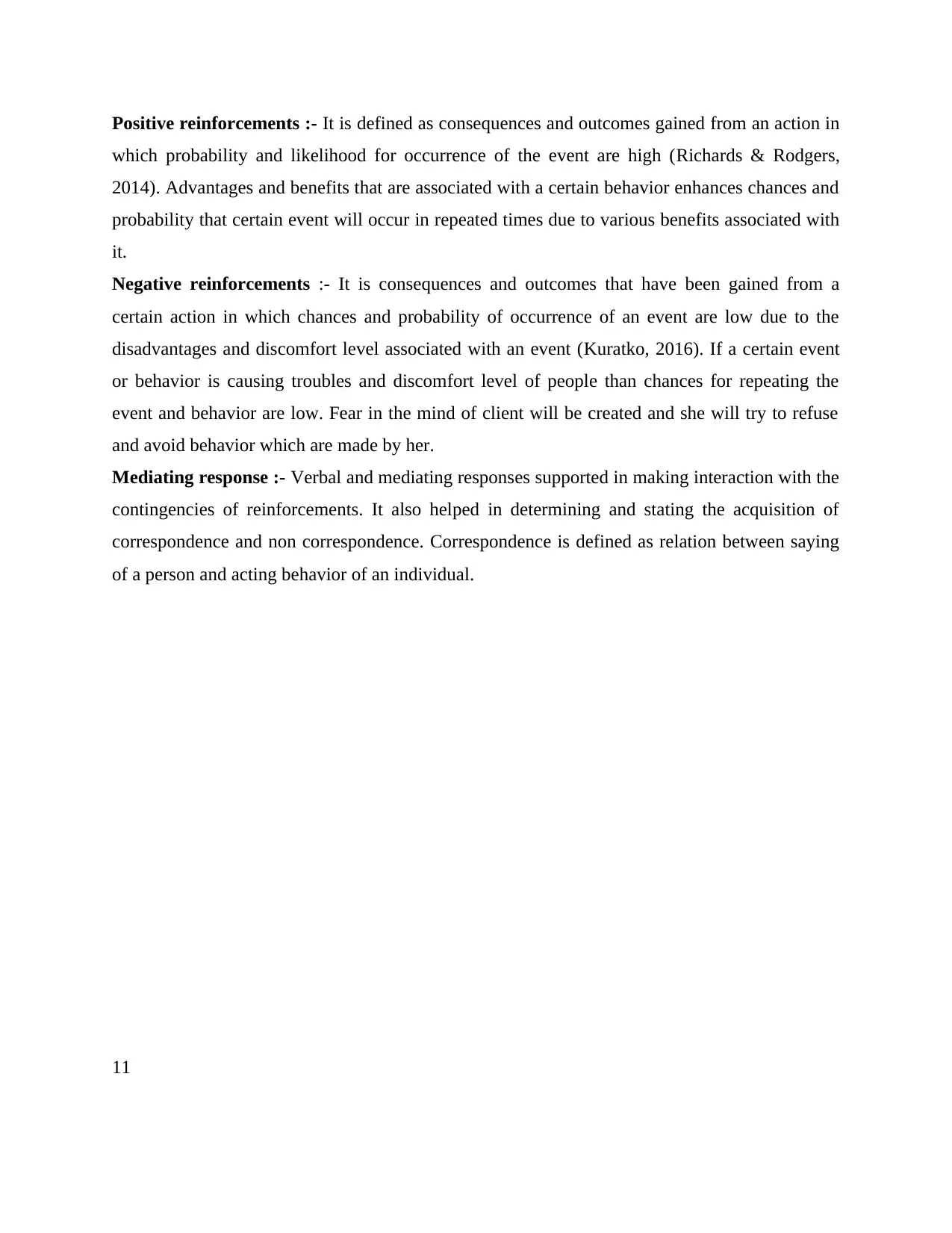
Positive reinforcements :- It is defined as consequences and outcomes gained from an action in
which probability and likelihood for occurrence of the event are high (Richards & Rodgers,
2014). Advantages and benefits that are associated with a certain behavior enhances chances and
probability that certain event will occur in repeated times due to various benefits associated with
it.
Negative reinforcements :- It is consequences and outcomes that have been gained from a
certain action in which chances and probability of occurrence of an event are low due to the
disadvantages and discomfort level associated with an event (Kuratko, 2016). If a certain event
or behavior is causing troubles and discomfort level of people than chances for repeating the
event and behavior are low. Fear in the mind of client will be created and she will try to refuse
and avoid behavior which are made by her.
Mediating response :- Verbal and mediating responses supported in making interaction with the
contingencies of reinforcements. It also helped in determining and stating the acquisition of
correspondence and non correspondence. Correspondence is defined as relation between saying
of a person and acting behavior of an individual.
11
which probability and likelihood for occurrence of the event are high (Richards & Rodgers,
2014). Advantages and benefits that are associated with a certain behavior enhances chances and
probability that certain event will occur in repeated times due to various benefits associated with
it.
Negative reinforcements :- It is consequences and outcomes that have been gained from a
certain action in which chances and probability of occurrence of an event are low due to the
disadvantages and discomfort level associated with an event (Kuratko, 2016). If a certain event
or behavior is causing troubles and discomfort level of people than chances for repeating the
event and behavior are low. Fear in the mind of client will be created and she will try to refuse
and avoid behavior which are made by her.
Mediating response :- Verbal and mediating responses supported in making interaction with the
contingencies of reinforcements. It also helped in determining and stating the acquisition of
correspondence and non correspondence. Correspondence is defined as relation between saying
of a person and acting behavior of an individual.
11

REFERENCES
Books and journals
Breen, M. (2014). Learner contributions to language learning: New directions in research.
Routledge.
Bresler, L. (Ed.). (2013). Knowing bodies, moving minds: Towards embodied teaching and
learning (Vol. 3). Springer Science & Business Media.
Capuzzi, D., & Stauffer, M. D. (2016). Counseling and psychotherapy: Theories and
interventions. John Wiley & Sons.
Getz, D., & Page, S. J. (2016). Event studies: Theory, research and policy for planned events.
Routledge.
Harker, R., Mahar, C., & Wilkes, C. (2016). An introduction to the work of Pierre Bourdieu: The
practice of theory. Springer.
Kintsch, W., & Vipond, D. (2014). Reading comprehension and readability in educational
practice and psychological theory. Perspectives on memory research: essays in honor of
Uppsala University's 500th Anniversary, L. Nilsson, Editor. 1979, Lawrence Erlbaum
Associates, 329-65.
Knowles, M. S., Holton III, E. F., & Swanson, R. A. (2014). The adult learner: The definitive
classic in adult education and human resource development. Routledge.
Kuratko, D. F. (2016). Entrepreneurship: Theory, process, and practice. Cengage Learning.
Lantolf, J. P., Thorne, S. L., & Poehner, M. E. (2015). Sociocultural theory and second language
development. Theories in second language acquisition: An introduction, 207-226.
Larson, J., & Marsh, J. (2014). Making literacy real: Theories and practices for learning and
teaching. Sage.
Laurillard, D., 2013. Rethinking university teaching: A conversational framework for the
effective use of learning technologies. Routledge.
Olson, M. H. (2015). An introduction to theories of learning. Psychology Press.
Peters, R. S. (2015). Psychology and Ethical Development (Routledge Revivals): A Collection of
Articles on Psychological Theories, Ethical Development and Human Understanding.
Routledge.
12
Books and journals
Breen, M. (2014). Learner contributions to language learning: New directions in research.
Routledge.
Bresler, L. (Ed.). (2013). Knowing bodies, moving minds: Towards embodied teaching and
learning (Vol. 3). Springer Science & Business Media.
Capuzzi, D., & Stauffer, M. D. (2016). Counseling and psychotherapy: Theories and
interventions. John Wiley & Sons.
Getz, D., & Page, S. J. (2016). Event studies: Theory, research and policy for planned events.
Routledge.
Harker, R., Mahar, C., & Wilkes, C. (2016). An introduction to the work of Pierre Bourdieu: The
practice of theory. Springer.
Kintsch, W., & Vipond, D. (2014). Reading comprehension and readability in educational
practice and psychological theory. Perspectives on memory research: essays in honor of
Uppsala University's 500th Anniversary, L. Nilsson, Editor. 1979, Lawrence Erlbaum
Associates, 329-65.
Knowles, M. S., Holton III, E. F., & Swanson, R. A. (2014). The adult learner: The definitive
classic in adult education and human resource development. Routledge.
Kuratko, D. F. (2016). Entrepreneurship: Theory, process, and practice. Cengage Learning.
Lantolf, J. P., Thorne, S. L., & Poehner, M. E. (2015). Sociocultural theory and second language
development. Theories in second language acquisition: An introduction, 207-226.
Larson, J., & Marsh, J. (2014). Making literacy real: Theories and practices for learning and
teaching. Sage.
Laurillard, D., 2013. Rethinking university teaching: A conversational framework for the
effective use of learning technologies. Routledge.
Olson, M. H. (2015). An introduction to theories of learning. Psychology Press.
Peters, R. S. (2015). Psychology and Ethical Development (Routledge Revivals): A Collection of
Articles on Psychological Theories, Ethical Development and Human Understanding.
Routledge.
12
⊘ This is a preview!⊘
Do you want full access?
Subscribe today to unlock all pages.

Trusted by 1+ million students worldwide
1 out of 13
Related Documents
Your All-in-One AI-Powered Toolkit for Academic Success.
+13062052269
info@desklib.com
Available 24*7 on WhatsApp / Email
![[object Object]](/_next/static/media/star-bottom.7253800d.svg)
Unlock your academic potential
Copyright © 2020–2025 A2Z Services. All Rights Reserved. Developed and managed by ZUCOL.





